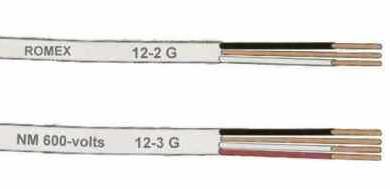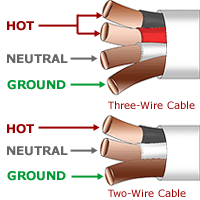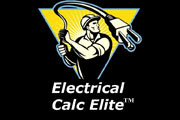Wire Types and Sizing
When wiring a house, there are many types wire to choose from, some copper, others aluminum, some rated for outdoors, others indoors. In general however, there are only a couple varieties used for wiring a residential home.


- Romex ™ is a common
type of residential wiring that is categorized by the
National Electrical Code (NEC) as underground feeder (UF) or
non-metallic sheathed cable (NM and NMC).
- NM and NMC conductors are composed of two or more
insulated conductors contained in a non-metallic sheath. The
coating on NMC cable is non-conducting, flame-resistant and
moisture-resistant. Unlike other cables commonly found in
homes, they are permitted in damp environments, such as
basements.
- Underground feeder conductors appear similar to NM and NMC cables except that UF cables contain a solid plastic core and cannot be “rolled” between fingers.
- They must be protected, secured and clamped to
device boxes, junction boxes and fixtures.
- Support devices that may damage the cables, such as
bent nails and overdriven staples, are not permitted.
- NM and NMC cables should be secured at intervals
that do not exceed 4½ feet, and they should be secured
within 12 inches of junction boxes and panels to which
they are attached. Cables that do not comply with this
rule can sag and are vulnerable to damage.
- They are intended as permanent wiring in homes and should not be used as a substitute for appliance wiring or extension cords.
Romex is used for most lighting and outlet circuits in your home. Romex will be labeled with "12-2" or "12-3". The first number indicates the gauge of the wire. You choices are typically 10, 12, or 14 gauge. The second number indicates the number of conductors. A 12-2 Romex will have a black(hot) and a white(neutral) wire as well as an unsheathed copper wire for ground. A 12-3 Romex will have a black(hot), red(hot), white(neutral), and bare copper. The red on a 12-3 is used for three-way light switches which are covered later.

12 gauge Romex is rated for 20 Amps and is commonly yellow jacketed. 14 gauge Romex is still used in some applications and is rated for 15 Amps and is grey jacketed. 10 gauge Romex has an orange jacket and is used for water heaters or clothes driers. For our cabin, we used 12 gauge Romex for all of the outlets and lighting circuits. This is very common now-a-days rather than running 14 gauge. In addition to Romex, wiring a house also requires a few larger gauge wires for high power appliances. Your air conditioner or electric stove would fall into this category. The table below list some common wire types and rated amperage for wiring a house.
| Wire Gauge or Type | Rated Amperage | Common Uses |
| 14-2 Romex | 15 A | Lighting Circuits |
| 12-2 Romex | 20 A | Lighting and Outlet Circuits, refrigerator |
| 10-2 Romex | 30 A | Electric water heater, baseboard heaters |
| 10-3 Romex | 30 A | Electric Clothes Dryer |
| 6/3 Cu Range Cable | 50 A | Range, Heatpump, On-Demand Electric Water heater |
| 2 Gauge Copper | 100 A | Central Electric Heat |
| AL 1/0 SER | 100 A | Aluminum 1/0-1/0-1/0-2 Service Feeder wire for 100 A breake panel |
| AL 4/0 SER | 200 A | Aluminum 4/0-4/0-4/0-2/0 Service feeder wire for 200A breaker panel |
To determine exactly how many amps you can run through a particular gauge wire and for more details on selecting the proper gauge wiring click here.
Common Electrical Wiring Diagrams
Frequently Asked Electrical Questions
Wire Gauge and Voltage Drop Calculator
NEC Reference Tables (2011, 2008, 2005, 2002, and 1999)
Residential Electrical Guidelines and Codes
Rough-In Electrical and Pulling Cable
Sizing Your Electrical Service
Electrical - Main Service Line Installation
Click the icons below to get our NEC® compliant Electrical Calc Elite or Electric Toolkit, both for Android. The Electrical Calc Elite is designed to solve many of your common code-based electrical calculations like wire sizes, voltage drop, conduit sizing, etc. The Electric Toolkit provides some basic electrical calculations, wiring diagrams (similar to those found on this website), and other electrical reference data.


